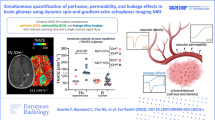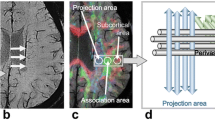Abstract
Objectives
To explore the oxygen metabolism level of different types of lesions in relapsing–remitting multiple sclerosis (RRMS) patients by oxygen extraction fraction (OEF) both cross-sectionally and longitudinally.
Methods
Forty-six RRMS patients and forty-one healthy controls (HC) went MRI examination. The quantitative susceptibility mapping (QSM) and OEF map were reconstructed from a 3D multi-echo gradient echo sequence. MS lesions in white matter were classified as contrast-enhancing lesions (CELs) on post-gadolinium T1-weighted sequence, paramagnetic rim lesions (PRLs), hyperintense lesions and non-hyperintense lesions on QSM, respectively. The susceptibility and OEF of different types of lesions were compared. The susceptibility and OEF values were measured and compared among different types of lesions. Among these RRMS patients, seventeen had follow-up MRI and 232 lesions, and baseline to follow-up longitudinal changes in susceptibility and OEF were measured.
Results
PRLs had higher susceptibility and lower OEF than CELs, hyperintense lesions, and non-hyperintense lesions. The hyperintense lesions had higher susceptibility and lower OEF than non-hyperintense lesions. In longitudinal changes, PRLs had susceptibility increased (P < 0.001) and OEF decreased (P < 0.001). The hyperintense lesions showed significant decreases in susceptibility (P = 0.020), and non-hyperintense lesions showed significant increases in OEF during follow-up (P = 0.005). Notably, hyperintense lesions may convert to PRLs or non-hyperintense lesions as time progresses, accompanied by changes of OEF and susceptibility in the lesions.
Conclusion
This study revealed tissue damage and oxygen metabolism level in different types of MS lesions. The OEF may contribute to further understanding the evolution of MS lesions.





Similar content being viewed by others
Data availability
The datasets generated or analyzed during the study are not publicly available due privacy of participants but are available from the corresponding author on reasonable request.
References
Dobson R, Giovannoni G (2019) Multiple sclerosis - a review. Eur J Neurol 26:27–40
Kato S, Hagiwara A, Yokoyama K et al (2022) Microstructural white matter abnormalities in multiple sclerosis and neuromyelitis optica spectrum disorders: evaluation by advanced diffusion imaging. J Neurol Sci 436:120205
Frischer JM, Weigand SD, Guo Y et al (2015) Clinical and pathological insights into the dynamic nature of the white matter multiple sclerosis plaque. Ann Neurol 78:710–721
Kuhlmann T, Ludwin S, Prat A, Antel J, Bruck W, Lassmann H (2017) An updated histological classification system for multiple sclerosis lesions. Acta Neuropathol 133:13–24
Filippi M, Brück W, Chard D et al (2019) Association between pathological and MRI findings in multiple sclerosis. The Lancet Neurology 18:198–210
Dal-Bianco A, Grabner G, Kronnerwetter C et al (2017) Slow expansion of multiple sclerosis iron rim lesions: pathology and 7 T magnetic resonance imaging. Acta Neuropathol 133:25–42
Guo Z, Long L, Qiu W et al (2021) The distributional characteristics of multiple sclerosis lesions on quantitative susceptibility mapping and their correlation with clinical severity. Front Neurol 12:647519
Marcille M, Hurtado Rua S, Tyshkov C et al (2022) Disease correlates of rim lesions on quantitative susceptibility mapping in multiple sclerosis. Sci Rep 12:4411
Rahmanzadeh R, Galbusera R, Lu PJ et al (2022) A new advanced MRI biomarker for remyelinated lesions in multiple sclerosis. Ann Neurol 92:486–502
Kaunzner UW, Kang Y, Zhang S et al (2019) Quantitative susceptibility mapping identifies inflammation in a subset of chronic multiple sclerosis lesions. Brain 142:133–145
Yao Y, Nguyen TD, Pandya S et al (2018) Combining quantitative susceptibility mapping with automatic zero reference (QSM0) and myelin water fraction imaging to quantify iron-related myelin damage in chronic active ms lesions. AJNR Am J Neuroradiol 39:303–310
Kim W, Shin HG, Lee H et al (2023) chi-separation imaging for diagnosis of multiple sclerosis versus neuromyelitis optica spectrum disorder. Radiology 307:e220941
Zivadinov R, Tavazzi E, Bergsland N et al (2018) Brain iron at quantitative MRI is associated with disability in multiple sclerosis. Radiology 289:487–496
Wu D, Zhou Y, Cho J et al (2021) The spatiotemporal evolution of MRI-derived oxygen extraction fraction and perfusion in ischemic stroke. Front Neurosci 15:716031
Shen N, Zhang S, Cho J et al (2021) Application of cluster analysis of time evolution for magnetic resonance imaging -derived oxygen extraction fraction mapping: a promising strategy for the genetic profile prediction and grading of glioma. Front Neurosci 15:736891
Cho J, Nguyen TD, Huang W et al (2022) Brain oxygen extraction fraction mapping in patients with multiple sclerosis. J Cereb Blood Flow Metab 42:338–348
Cho J, Zhang S, Kee Y et al (2020) Cluster analysis of time evolution (CAT) for quantitative susceptibility mapping (QSM) and quantitative blood oxygen level-dependent magnitude (qBOLD)-based oxygen extraction fraction (OEF) and cerebral metabolic rate of oxygen (CMRO2) mapping. Magn Reson Med 83:844–857
Cho J, Spincemaille P, Nguyen TD, Gupta A, Wang Y (2021) Temporal clustering, tissue composition, and total variation for mapping oxygen extraction fraction using QSM and quantitative BOLD. Magn Reson Med 86:2635–2646
Liu Z, Spincemaille P, Yao Y, Zhang Y, Wang Y (2018) MEDI+0: Morphology enabled dipole inversion with automatic uniform cerebrospinal fluid zero reference for quantitative susceptibility mapping. Magn Reson Med 79:2795–2803
Kee Y, Liu Z, Zhou L et al (2017) Quantitative susceptibility mapping (QSM) algorithms: mathematical rationale and computational implementations. IEEE Trans Biomed Eng 64:2531–2545
Shi Z, Pan Y, Yan Z et al (2023) Microstructural alterations in different types of lesions and their perilesional white matter in relapsing-remitting multiple sclerosis based on diffusion kurtosis imaging. Mult Scler Relat Disord 71:104572
Eskreis-Winkler S, Deh K, Gupta A et al (2015) Multiple sclerosis lesion geometry in quantitative susceptibility mapping (QSM) and phase imaging. J Magn Reson Imaging 42:224–229
Zhang Y, Gauthier SA, Gupta A et al (2016) Magnetic susceptibility from quantitative susceptibility mapping can differentiate new enhancing from nonenhancing multiple sclerosis lesions without gadolinium injection. AJNR Am J Neuroradiol 37:1794–1799
Zhang S, Nguyen TD, Zhao Y, Gauthier SA, Wang Y, Gupta A (2018) Diagnostic accuracy of semiautomatic lesion detection plus quantitative susceptibility mapping in the identification of new and enhancing multiple sclerosis lesions. Neuroimage Clin 18:143–148
Chen WW, Gauthier SA, Gupta A et al (2014) Quantitative susceptibility mapping of multiple sclerosis lesions at various ages. Radiology 271:183–192
D’Haeseleer M, Cambron M, Vanopdenbosch L, De Keyser J (2011) Vascular aspects of multiple sclerosis. The Lancet Neurology 10:657–666
Trapp BD, Stys PK (2009) Virtual hypoxia and chronic necrosis of demyelinated axons in multiple sclerosis. Lancet Neurol 8:280–291
Wenzel N, Wittayer M, Weber CE, Platten M, Gass A, Eisele P (2022) Multiple sclerosis iron rim lesions are linked to impaired cervical spinal cord integrity using the T1/T2-weighted ratio. J Neuroimaging. https://doi.org/10.1111/jon.13076
Wittayer M, Weber CE, Kramer J et al (2023) Exploring (peri-) lesional and structural connectivity tissue damage through T1/T2-weighted ratio in iron rim multiple sclerosis lesions. Magn Reson Imaging 95:12–18
Stephenson E, Nathoo N, Mahjoub Y, Dunn JF, Yong VW (2014) Iron in multiple sclerosis: roles in neurodegeneration and repair. Nat Rev Neurol 10:459–468
Weber CE, Wittayer M, Kraemer M et al (2022) Long-term dynamics of multiple sclerosis iron rim lesions. Mult Scler Relat Disord 57:103340
Zhang S, Nguyen TD, Hurtado Rua SM et al (2019) Quantitative susceptibility mapping of time-dependent susceptibility changes in multiple sclerosis lesions. AJNR Am J Neuroradiol 40:987–993
Calvi A, Clarke MA, Prados F et al (2023) Relationship between paramagnetic rim lesions and slowly expanding lesions in multiple sclerosis. Mult Scler 29:352–362
Funding
This work was supported by the National Natural Science Foundation of China (grant. No:81730049 and No: U22A20354).
Author information
Authors and Affiliations
Contributions
Yan Xie: Conceptualization, Formal analysis, Investigation, Writing—Original Draft. Shun Zhang: Investigation, Formal analysis. Di Wu: Investigation and Resources. Yihao Yao: Resources. Junghun Cho: Methodology. Jun Lu: Investigation. Hongquan Zhu: Resources. Yi Wang: Methodology. Yan Zhang: Conceptualization, Writing—Review & Editing. Wenzhen Zhu: Resources, Supervision, Funding acquisition.
Corresponding authors
Ethics declarations
Ethical approval
This study was approved by Ethics Committee of Tongji Hospital Affiliated to Tongji Medical College, Huazhong University of Science and Technology (TJ-IRB20231102).
Informed consent
was obtained from all individual participants for whom data is included in this article.
Consent to participate
Informed consent was obtained from all individual participants included in the study.
Conflict of interest
The authors have no potential conflicts of interest to disclose.
Additional information
Publisher's Note
Springer Nature remains neutral with regard to jurisdictional claims in published maps and institutional affiliations.
Supplementary Information
Below is the link to the electronic supplementary material.
Rights and permissions
Springer Nature or its licensor (e.g. a society or other partner) holds exclusive rights to this article under a publishing agreement with the author(s) or other rightsholder(s); author self-archiving of the accepted manuscript version of this article is solely governed by the terms of such publishing agreement and applicable law.
About this article
Cite this article
Xie, Y., Zhang, S., Wu, D. et al. The changes of oxygen extraction fraction in different types of lesions in relapsing–remitting multiple sclerosis: A cross-sectional and longitudinal study. Neurol Sci (2024). https://doi.org/10.1007/s10072-024-07463-2
Received:
Accepted:
Published:
DOI: https://doi.org/10.1007/s10072-024-07463-2




